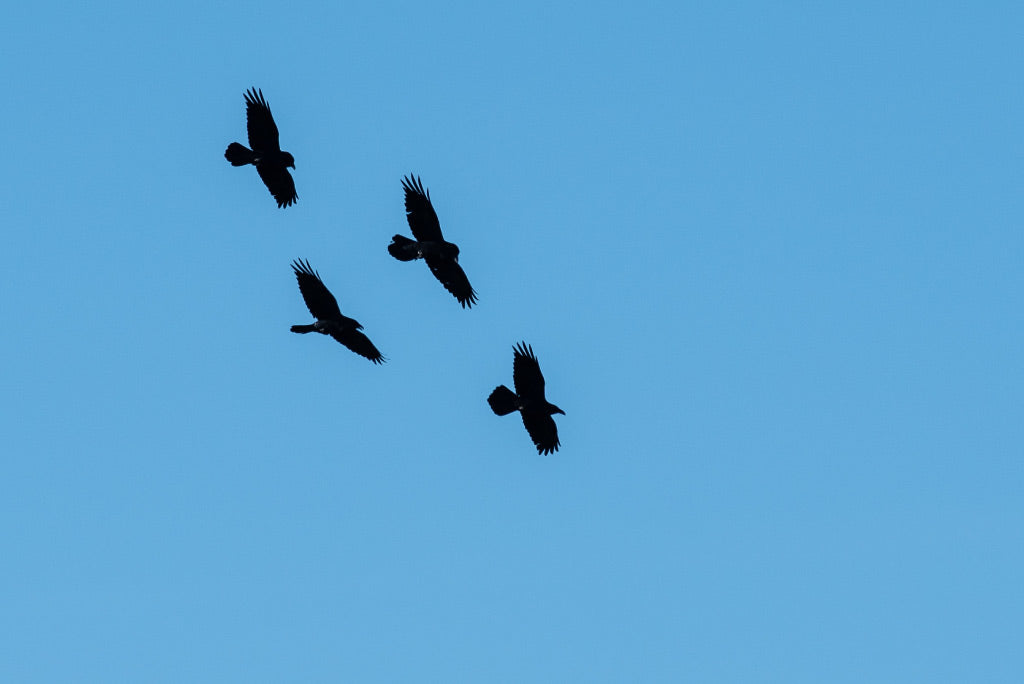What we can Learn from ravens about joy and running

By Jason Mazurowski
I have an affinity for ravens – those creatures of the boreal forest, denizens of cliffs and mountaintops, among the smartest of our birds. During a low point on any run, no matter how long or cold or miserable, when I hear a raven croak, my spirit lifts. When I see their silhouettes drifting above evergreen spires, my legs feel lighter. I forget my aching Achilles, my blistered, pruning feet and I grin from ear to ear. I’ll pick up the pace and try to follow in pursuit, scrambling out onto a ledge or up a sturdy spruce just to catch a view of ravens at play.
Anyone who’s spent time in the company of ravens has likely witnessed their “tumbling” behavior. They’ll start by catching a gust of wind, riding it high above a notch or a rocky, alpine summit. They remain suspended for a moment, before tucking their wings and taking the plunge – falling, spinning, and flipping in barrel-roll fashion down to the valley below.
Why do somersaulting ravens bring me so much joy? It is relatively common to see birds participating in all sorts of acrobatics as territorial displays or mating rituals, but this behavior is different. I’ve seen them tumble in pairs or in groups, and I’ve seen them tumble alone, often for an hour or more – but each time is with a sense of purpose and playfulness. Perhaps catching a glimpse of another intelligent creature in a playful pursuit reminds me that running is a similar endeavor – at least it starts that way. Why else would we subject ourselves to long bouts of brutality if we were not rewarded with joy?
Running is often synonymous with pain. We willingly deprive our muscles of oxygen, bludgeon our joints and burn precious calories day in and day out with little promise of economic reward. In fact, running often brings about the opposite. We spend hundreds of dollars on race fees, shoes, gear and food. But we do it all for those fleeting moments of joy – opening a stride on a long, gentle downhill. Soaking our feet in a cool mountain stream. Crossing a finish line after hours of racing, days of preparing, weeks of tapering, and months of training.
For those of us who run competitively, it can seem like a full-time job. Those moments of joy become muddled, diluted, fewer and farther between as we cram workouts into our commutes and plan vacation days around races. We expend precious resources – time, money, and calories. Running loses its playfulness and becomes habitual, irrational, and sometimes fanatical.
There are practical, scientific explanations for play – strengthening social bonds, fine-tuning motor skills, exercising our body and mind, perpetually refining fitness for an ultimate test of survival. Nearly all intelligent creatures participate is some form of play: wolves, dolphins and ravens to name a few. But for humans, at least, joy seems to transcend practicality. Our own joyful pursuits are often irrational and sometimes directly compromise our long-term survival – we throw ourselves out of airplanes, slide down mountains at high speeds, or run 100 miles at a time. Sometimes we derive joy from reading a book, eating an entire pizza, or watching birds on a spring afternoon. Our pursuits of joy require varying degrees of risk, but ultimately do not produce any immediate rewards.
Last winter, while running along the limestone bluffs of Lake Champlain, I heard a familiar croak. My eyes snapped to the sky to see a raven rise with the thermals, so close I felt its wingbeats against my chest. It tucked its wings, flipped, and dived back down to the water, soaring just above the waves. I followed along as it circled above the cliffs, where it eventually perched next to its mate on a gnarled cedar snag.
For the rest of the winter I visited that spot as often as I could, and almost every time, I’d encounter the ravens. One warm day in early spring, I heard the sound of raven chicks begging for food. I worked my way along the cliffs, continuing to listen. I got down on my belly and crawled to the edge, peering down to see the nest – a haphazardly assembled jumble of sticks, tucked underneath an overhanging ledge. Inside were four baby ravens, mouths open, covered in fluffy down.
From that day on, I barely cared about mileage or training plans. Race day was the furthest thing from my mind and running became merely a byproduct of my evening ritual. The raven family was the reason for me to lace up my running shoes and head down to the waterfront each night. Even with four, relentless, begging mouths to feed they still found the time to tumble in the wind. Sometimes, with their beaks still full of food, they’d take a few moments to rise, flip and dive before landing in the nest to make the delivery.
The chicks continued to grow, and all the while the adults adhered to their irrational, playful spirit – and it was contagious. Just hours before, I had been teaching classes and sitting through meetings, but there I was transformed into a kid again, laying on my stomach, covered in dirt and watching ravens. I ran home every night with a smile on my face.
Wherever we are on our journeys as runners – competitive athletes chasing an FKT, training for a first ultra, or just looking to enjoy the trails – we can all learn a lesson or two from stopping to watch the ravens. On every run, whether I’m in their presence or not, I try to think about the ravens and their tumbling. If only to recalibrate or to evoke their joyful disposition. Rationality be damned, I’m happy to be running.